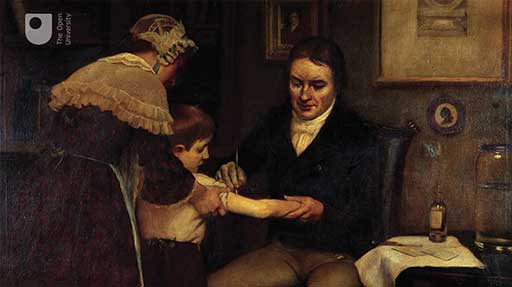Session 2: Scientific lessons from the history of infectious diseases
Introduction
In Session 2 you'll look at the conditions in England in the 18th and 19th centuries which help to explain the high rates of death and sickness in the past from infectious diseases, such as cholera and smallpox. Similar living conditions still exist in parts of the world where infectious diseases remain the principal threat to health. Evidence for the impact of infectious diseases on populations comes partly from statistical studies of data on deaths from infection, which began in England in the 19th century.
You will analyse two classic experiments from the history of infectious diseases to identify the key features of the scientific method of investigation. These are significant because the origins of public health and mass vaccination programmes can be traced back to these two experiments. One of these classic experiments eventually contributed to the eradication of smallpox.
In the video, Dr Claire Rostron, Senior Lecturer in Health Sciences at The Open University, describes this in more detail.

Transcript
CLAIRE ROSTRON: Smallpox is an infectious disease characterised by the appearance of pus-filled sores all over the body. It is incredibly painful and causes death in around one third of cases. But the last case of naturally transmitted smallpox occurred in 1977. And in 1980, the World Health Organisation announced that it had eradicated cases of smallpox throughout the world.
Science had a very unethical role to play in this eradication of smallpox, almost 200 years earlier. In 1796, an English doctor called Edward Jenner tested the first form of vaccination on a young boy called James Phipps, who was the son of Jenner's gardener. At the time, smallpox was widespread. But Jenner had apparently overheard a milkmaid bragging that she would never catch smallpox because she had previously suffered with cowpox.
Jenner decided to test this, first taking samples of pus from a dairymaid infected with cowpox and rubbing the pus into scratches that he had made on the arm of young James. Of course, James developed cowpox-- and recovered. But the next step was the most unethical of all.
Jenner next deliberately infected James with smallpox pus, to see if he'd develop the disease. If the milkmaid was right, James would be fine. If she was wrong, James could die. Thankfully, Jenner's experiment was successful, and James was fine. In fact, he remained fine after several attempts to infect him with smallpox.
Although Jenner didn't know what caused smallpox or why the cowpox was protective, he developed a very early form of the scientific method - albeit a highly unethical one. And this led to the eventual eradication of smallpox nearly 200 years later. You'll be learning more about Jenner and his experiment, as well as another example of the development of the scientific method, in this OpenLearn course.
